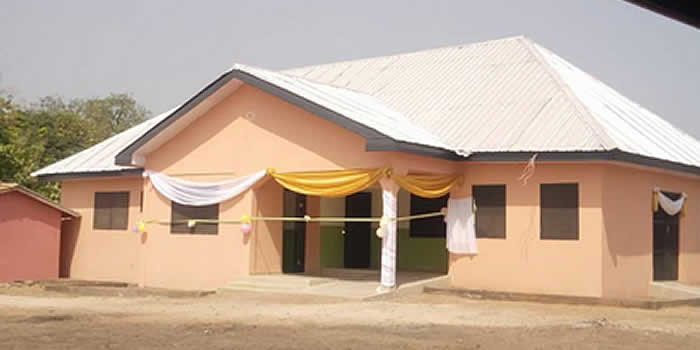

The vulnerable and excluded people in society have always been disadvantaged. Categories of these people found in the district are- People with Physical Disabilities (PWPD), People Living with HIV/AIDS (PLWHA), The Aged, Children, and Women.
Poverty here is defined as the inability to attain a minimal standard of living. This definition is applicable to an individual as well as a community. However the case of individual, and in the Ghanaian context, a person is categorized as poor if he/she obtains an income which is 2/3 below the national average minimum income. Krachi Nchumuru District has a large rural population of eighty percent (79.5%) which depend mainly on agriculture. The incidence of poverty is largely felt in the rural areas and within the agricultural sector and for that reason, the District faces a huge problem of alleviating poverty and raising the standard of living of the people.
The average monthly consumption per capita for the district is very low. The poor spend all their income in any one particular year. At least 63% of this consumption is on food and this immediately indicates its impact on the nutritional status of the district. Within the households, the distribution of consumption often favours males and income-earning adults. Women are at disadvantage even though they are potential medium in the nutritional upkeep of their families.
The poor of the district have distinctive source of livelihood and these include a mix of different earnings and activities such as cultivators/gatherings and as wage earners (who hire out their labour), and as petty traders and artisans. The levels of income attracted by these groups are so minimal that the implications of this factor on development cannot be over emphasized.
With 79.5% of the population in the rural areas, agricultural has become their main source of income. Rural non-farm employment includes cottage industries and petty trading, which are however seasonal or part time and earnings from these services are low. Demand is an important constraint on the non-farm economic activities as demand for these services are very low.
Transfers/remittances have been an important source of income which helps to cushion off the harsh economic situation of the poor.
There are indications that some people move out of poverty while others are permanently stuck in it. Households have therefore adopted various strategies to reduce the risk poverty causes by diversifying their sources of income. Some of the coping mechanisms are peasant farming, hunting, charcoal burning, harvesting of fire wood for scale, engaging in small income generating ventures, serving as casual farm labourers, and dependence on relatives and friends for financial assistance.
Credit is rarely available for accumulating assets. The only assets that have been freely available to the poor are labour and at times access to land of which have however been variously affected by the following;
a) Inadequate human capital that eventually makes the poor becomes limited unskilled worker.
b) Unhealthy conditions, which cannot enhance their capacity for labour, and eventually be forced to rely on charity
c) Ageing and incapacitation thus depriving them of the chance to sell their labour
d) Lack of ownership rights which force the poor into hiring out their labour or go into tenancies, which cannot provide collateral or secure a hedge against risk.
The majority of the populations who live on agriculture are also poor. The main enterprise of the poor has been the family farm. The initial boost achieved by the family farm in taking off this existence into commercial farming could not be sustained because the existing structure and method of operation of the family farm could not cope with the changing service supply and activities as well as the technological modernisation.
The family farm reached a crossroad where the cornerstone issue was expansion and increase of the farm enterprise and its related services. This meant that production increased to meet market demand; it means the introduction of new products; it presupposed increased capacity to store, transport and process. In fact all production and service operations were to be designed with efficiency that will cope with the economies scale.
When the family could not have the services of the supporting system, it declined to the extent that the poor, who own them, has now less access to publicly provide goods and infrastructure and in certain situation have been denied the chance to use the services to come out of their poverty.
Another group considered vulnerable are persons with disability. The total number of people with any form of disability in the Krachi Nchumuru District is 2,523 representing 3.5 percent of the total population with 3.5 percent males and 3.4 percent females. Available records from the District Social Welfare Department indicate that about 80 PWPD have so far registered with the Department. However, efforts are being made to cover the rest of the people in this category in order for the district to plan for them.
There are also slightly more persons with disability in the urban areas (6.8%), compared to rural areas (2.6%). Sight impairment is the main type of disability accounting for 42.4 percent in the District followed by intellectual disability accounting (21.0%) and speech disability (9.7%).
Linking disability to employment, 60.6 percent of those with disability are employed. Again, many PWDs are not economically active (45.2%) compared to their non-disabled counterparts (27.9%). It is further evident that more males with disability (69.1%) as against (52.1%) of females with disability are employed.
Furthermore, Population 3 years and older by level of education, school attendance and sex shows that the highest and lowest percentage of the population 3 years and older are in the primary school level (51.9%) and vocational/technical/commercial level (0.2%) respectively. It can also be observed that only a small number of the population 3 years and older are in the tertiary level (0.5%).
An analysis of both sexes indicates that majority of the population 3 years and older are in the primary level (32.4%) while the least are in the vocational/technical/commercial level (1.9%). There are indications that from the nursery level to the primary level, the proportion of females currently attending school is more than that of males, however, from the JSS/JHS level to the tertiary level the proportion of males currently attending school are more than the females. This shows that the number of females decline as they ascend the educational ladder.
People Living with HIV/AIDS
The Krachi Nchumuru District is no exception to the effect of this dreadful disease, which has become a developmental problem. Currently, there are no available statistics on the number of PLWHA in the district. However, unconfirmed reports indicate that there is a considerable number of PLWHA in the district. Due to this, the situation of the people in the district is even more dangerous since there is no factual evidence of identified people with HIV/AIDS. The District Health Directorate is making frantic efforts to collect data on PLWHA. Since data on PLWHA is not available now in the district, it will be difficult to formulate policies to salvage this canker. Nonetheless, public awareness campaign would be intensified to reduce the spread of the disease.
The Aged
Day-in, day-out, we are all on the journey of being aged. The aged people in the district form about 7.19% (3,155) of the 2010 Population and Housing Census. Some of these elderly people suffer from age chronic related diseases and have little or no support. Such people are poor, almost neglected by their own kinsmen and become socially excluded.
Children
Children in the district are not considered when it comes to taking decisions on the grounds of age, not even when it affects them. Children are only seen and not heard neither do they have the right to opinion. According to the UN Convention on the right of the child, children are to enjoy certain rights like freedom of expression. Contrary to this, the picture is quite different in the District.
Yet another issue of great concern is child labour. A considerable number of households engage the services of house-helps between the ages of 10 – 17. Some of these children are badly treated and exploited. Related to this are isolated cases of child abuse. There are also orphans and needy children in the district, though available data on them is scanty.
Women
Though women play important role in the rural economy, they are discriminated against by society when it comes to decision-making, formal education as well as employment in the district. According to the 2000 Population and Housing Census, the Krachi Nchumuru District is among the districts whose male population is more than females. Despite their proportionately less population, they still suffer vulnerability and exclusion.
For instance, there is high illiteracy rate among women in the District and this has affected their chances of being employed in the formal sector – an indication of poverty and vulnerability. The perception of the society towards women is also a major factor contributing to women discrimination in the District. Generally, women in the district are not empowered to be involved in decision-making and other issues that affect them. This situation has serious implication for women welfare and general development of the district.
The District has a higher proportion of households (26.9%) headed by males compared to households headed by females (7.2%). This implies that about four out of every seven households is headed by males and further implies that even though female-headed households are increasing, the percentage is still not very significant and therefore when it comes to decision making the male dominates. This shows the patriachical nature of the various ethnic groups in the District. A trend is emerging in relation to widowhood where females widowed are about eight times higher than their male counterparts (9.1% versus 1.3%). The percentage of the population who are widowed increase with age to the extent that by age 65 years and over about one of every three (34.4%) are widowed. There are substantial variations between males and females.
The proportion of male household heads is 26.9 percent as shown in Table 3 which is over five times higher than that of females of 7.2 percent. On the other hand, female spouses constitute 22.0 percent of household members while the male spouses constitute less than one percent of the total household population
Date Created : 11/23/2017 1:52:05 AM











 facebook
facebook
 twitter
twitter
 Youtube
Youtube
 +233 593 831 280
+233 593 831 280 0800 430 430
0800 430 430 GPS: GE-231-4383
GPS: GE-231-4383 info@ghanadistricts.com
info@ghanadistricts.com Box GP1044, Accra, Ghana
Box GP1044, Accra, Ghana